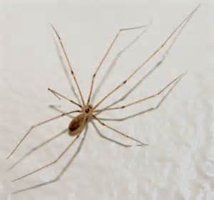
|
Some Common Myths Thought to be True - Myth 50
Myth 50: Daddy Longlegs, most Venomous Spider
There is an urban legend stating that daddy long-legs spiders have the most
potent venom of any spider, but that their chelicerae (fangs) are either too
small or too weak to puncture human skin; the same legend is also repeated of
the harvestman and crane fly, also called "daddy long-legs" in some locales.
Indeed, pholcid spiders do have a short fang structure (called uncate).
|
| Daddy Longlegs | |
|
There is an urban legend stating that daddy long-legs spiders have the most
potent venom of any spider, but that their chelicerae (fangs) are either too
small or too weak to puncture human skin; the same legend is also repeated of
the harvestman and crane fly, also called "daddy long-legs" in some locales.
Indeed, pholcid spiders do have a short fang structure (called uncate).
However, brown recluse spiders also have uncate fang structure, but are able to
deliver medically significant bites. Either pholcid venom is not toxic to
humans or there is a musculature difference between the two arachnids, with
recluses, being hunting spiders, possessing stronger muscles for fang
penetration.
|
|
| ⇦ Back to Myth 49 Return to Myth Choices Page 4 On to Myth 51 ⇨ | |